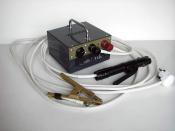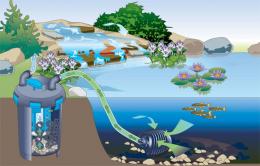Search
Login
Recommended
Filtration systems of decorative ponds on a personal plot. Pond filtration
The pond of its original form, with crystal clear and clear water, incredibly decorates the site. Especially if the edges of the pond are decorated with green spaces and decorated with stones of their original shape. Just clean water in the pond becomes turbid too quickly, and in order to keep it transparent it is necessary to install filtration systems on it.
Content
- When is a filtration system needed and how does it work
- The device of a decorative reservoir
- How to make a pond do-it-yourself video
- Types of filters for artificial ponds
- Skimmer Jebao SK 30 video
- DIY pond filtering
- DIY pond filter video
When is a filtration system needed and how does it work
Often, the pond carries not only a decorative, but also a functional load. It breeds rare breeds of fish or plants. The waste of their life activity settles to the bottom of a muddy suspension, which can lead to the fact that a clean pond turns into a fetid, muddy swamp. The filtration system for the pond allows you to cope with this problem without difficulty, purifying and filtering the water, making it transparent.

There are several types of filtration systems, but all of them are similar in one, passing water through the filter chamber, they return it to its original purity.
The device of a decorative reservoir
Even at the stage of choosing a place for an artificial reservoir, it is necessary to determine its size in advance. In small and shallow ponds, water becomes turbid much faster, and in larger and larger ponds, maintaining ecological balance is much easier. Therefore, the choice of a place under the pond should be made taking into account the size.

After the site is selected, the foundation pit is prepared for the pond. The easiest and fastest way to install the finished bowl, which are offered in abundance by manufacturers. However, this option will not be affordable for everyone and therefore it is possible to limit the construction of a concrete base or simply cover the bottom of a reservoir with a waterproofing film. Moreover, it should be remembered that if planting is planned in a decorative pond, then steps, recesses and ledges under them will need to be done even at the stage of excavation.
The water filtration system is installed in a ready-made pond, in which plants are planted and decorative fish released.
Types of filters for artificial ponds
Mechanical filters. Designed to remove large debris. A container with a filler, through which water is passed, is built into the design of this device. As a result of this, it is possible to collect fallen leaves, branches and large grains of sand. Most often, this filter is used for pre-treatment of a reservoir.

Skimmer. This device is of local action and is able to collect only the garbage that floats on the surface of the reservoir and has not yet drowned.

When the pump is turned on, the top layer is set in motion and is directed towards the skimmer, which sucks in all the twigs, wood chips and other waste. There are several modifications of the skimmer.
- Rack. This filter is installed directly on the bottom and is attached to the rack. The upper, working part of it is located on the surface and can be adjusted automatically with minor water drops.
- Side. Mounted directly to the edge of the pond.
- Floating. The most convenient device that does not need to be adjusted manually. Its working part floats on the surface and works regardless of the water level in the pond.
Multi-chamber filter systems. Three types of filters are provided for in the design of this system, each of which is responsible for a separate cleaning step. With its help, pond filtration occurs as follows:
- UV irradiation is performed.
- The resulting lumps of algae are removed mechanically.
- The biological filter purifies the water from cloudy suspensions and tiny plant particles.

Thus, in three stages, high-quality and thorough filtration of water in the pond is performed.
DIY pond filtering
If desired, a filter for the pond can be made with your own hands. This will require very little time and minimal investment.

As materials for the manufacture, you can use an ordinary plastic bucket and an old pump from the aquarium.
The bucket should have a volume of at least 10 liters and it is advisable to paint it in advance in a dark color.
Step 1. A hole for the pump is cut out in the bucket lid. It should have the same dimensions as the filter element. In addition, in the lid you will need to drill another hole for the air to exit. At the bottom of the bucket, a series of circular holes are drilled in order to ensure a free flow of water into it.
Step 2. Fix the pump in the cover with hot melt adhesive.
Step 3. Lay stones at the bottom of the bucket in order to make the structure heavier and make it drown when immersed.
Step 4. Place a filter element on the stones (this can be ordinary foam rubber) and press it firmly, leaving free space for the frame of the filter element of the pump.
Step 5. Place the lid on the bucket and screw it securely onto the handle ears.
Actually, that’s all. A self-made filtration system is ready and it can be safely lowered to the bottom of an artificial reservoir and connected to a power source. The stones at the bottom of the bucket will help you quickly submerge a home-made structure on the bottom and set it upright. If necessary, rinse this filter is not difficult and it will be enough just to raise the bucket to the surface and thoroughly rinse the foam and stones.





